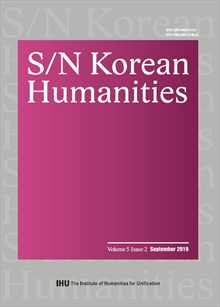간행물
통일인문학 KCI 등재 S/N Korean Humanities

- 발행기관 건국대학교 인문학연구원
- 자료유형 학술지
- 간기 반년간
- ISSN 2384-0668 (Print)2384-0692 (Online)
- 수록기간 2015 ~ 2019
- 주제분류 인문학 > 기타인문학 인문학 분류의 다른 간행물
- 십진분류KDC 001DDC 000
권호리스트/논문검색
제5권 제2호 (2019년 9월) 5건
Feature Articles
1.
2019.09
서비스 종료(열람 제한)
This paper discusses the Korean urban space by focusing on capital cities and how they structure the Korean “meta-nation”, i.e. this very unique cultural space, attached to the locus of the Korean peninsula and coherent over the historical longue durée, currently split into two States and fragmented into great diasporic communities, which positions are determined by political polarization. It is based on the analysis of geographical discourse on Korean “capital cities”, and “capitalness”, as the quality of some cities able to take on the power that comes with a central political role, even if they are not or no longer the current capital, in various secondary sources in English and Korean. Next to the great capitals of Korean geo-history (hyper-capitals of the present States, Pyongyang and Seoul, or legitimizing historical capital cities such as Kaesong and Kyŏngju), de-capitalized cities such as Suwŏn, forgotten or marginalized capitals, such as Puyo, or Kongju) form an archipelago of capitals. This archipelago of “hyper-capitals” and “shadow capitals” is scattered not only across the peninsula itself, but is also connected to many capital cities of the Korean diaspora: from the North American diaspora’s Koreatown in Los Angeles to the Central Asian diaspora’s Almaty in Kazakhstan.
2.
2019.09
서비스 종료(열람 제한)
Territory and landscape are vitally important to both nations currently on the Korean peninsula. Historically both Koreas have contested and imagined the others territory as their own. However, both Koreas have both been forced to consider what the landscape of the other might look like at the moment of or following unification. Occasionally both Koreas have joined together to enact and imagine such moments of unification. This paper in particular considers arboreal elements of geography and topography reproduced at moments of intersection between the two Koreas, and how they are historically framed, imagined and grounded and embodied in real materiality, so they are not just imagined places in the future, but places of imagination in the present. Specifically, this paper focuses on a ceremonial tree planting ceremony on the April 27, 2018 between Kim Jong Un and Moon Jae-in at the April 2019 Inter-Korean Summit held at Panmunjom in the Joint Security Area. Using the work of Denis Cosgrove, Nak-chung Paik, Gilles Deleuze, Heonik Kwon and Byung-ho Chung, the paper places the ceremony and other symbolic elements that day within a wider historical-geographical and transnational frame of the place of trees and topographic features at moments in which both practices of political authority and unification are performed and enacted in Korean history.
3.
2019.09
서비스 종료(열람 제한)
The architecture developed in North Korea since its foundation in 1948 but especially since the proclamation of the Juche thought as the unique state ideology in the early 1960s, has included two major referential imaginaries: the Korean traditional architecture and the expression of the economic and technological progress. The presence of these imaginaries, mediated by the architectural language but also by the production policies, have oscillated throughout decades with varying intensity under the rule of each of the three Kims. The paper analyses different elements of traditionally and technologically inspired architecture, resumed in the title in two significative elements, the hapkak roof and the glass curtain wall, and looks into their transformation and modern interpretation in different times. The aim is to link the dominance of either of those imaginaries with the epoch and political discourses of Kim Il Sung, Kim Jong Il and Kim Jong Un, as tools for establishing the periodicity of contemporary North Korean architecture despite the omnipresent discourse of the national character of North Korean architecture. All three leaders have had strong influence on the architectural creation, understood as regimes’ most valuable propaganda device and have preferred one over another imaginary. It will also be interesting to link these variations with changes in the international architectural scene.
Article
4.
2019.09
서비스 종료(열람 제한)
This study examines the historical trajectory of and the impetus for the selection of bulgogi by the Koreans residing in Japan, contextualized in Japanese history as well as vis-à-vis theories of cultural anthropology and the practice thereof. Moreover, it focuses on the cultural-economic and diachronic processes of bulgogi’s development into a veritable ethno-national food industry amidst the influence of Japanese society upon Korean-Japanese dietary habits. Finally, the study addresses the place of Korean culinary traditions, including bulgogi, in education that may impart a sense of Korean ethno-nationalist consciousness in the third-, fourth-, and fifth-generation Korean- Japanese in various social spaces within Japanese society. This is so done in face of lived experiences in the attempts to solve the problem of heritance of ethno-nationalist consciousness for the Korean-Japanese people. In sum, three suggestions are forwarded: 1) In the future, it will be necessary to produce talented individuals who can cultivate ethno-nationalism through a systematic study of the culinary traditions of Korea. In addition, possibilities for extending to other grade levels the courses that are currently executed at the middle-school first-grade level must be explored; 2) Through regularly held re-education that includes research and seminars by and for the Korean-Japanese people in the food industry in not only Japan, but also in South Korea, possibilities toward a more creative, progressive culinary culture for Korean food, including bulgogi made of wagyu, Korean beef, as well as other types of beef, should be sought from the persepective of nutrional science and management systems; and 3) In sharing common goals of the disparate groups in the Korean diaspora, including the Korean-Chinese people in Yanbian, possibilities for collaborative research should be explored, and the problem of cultivating ethno-nationalist consciousness on foreign soil must be discussed.

